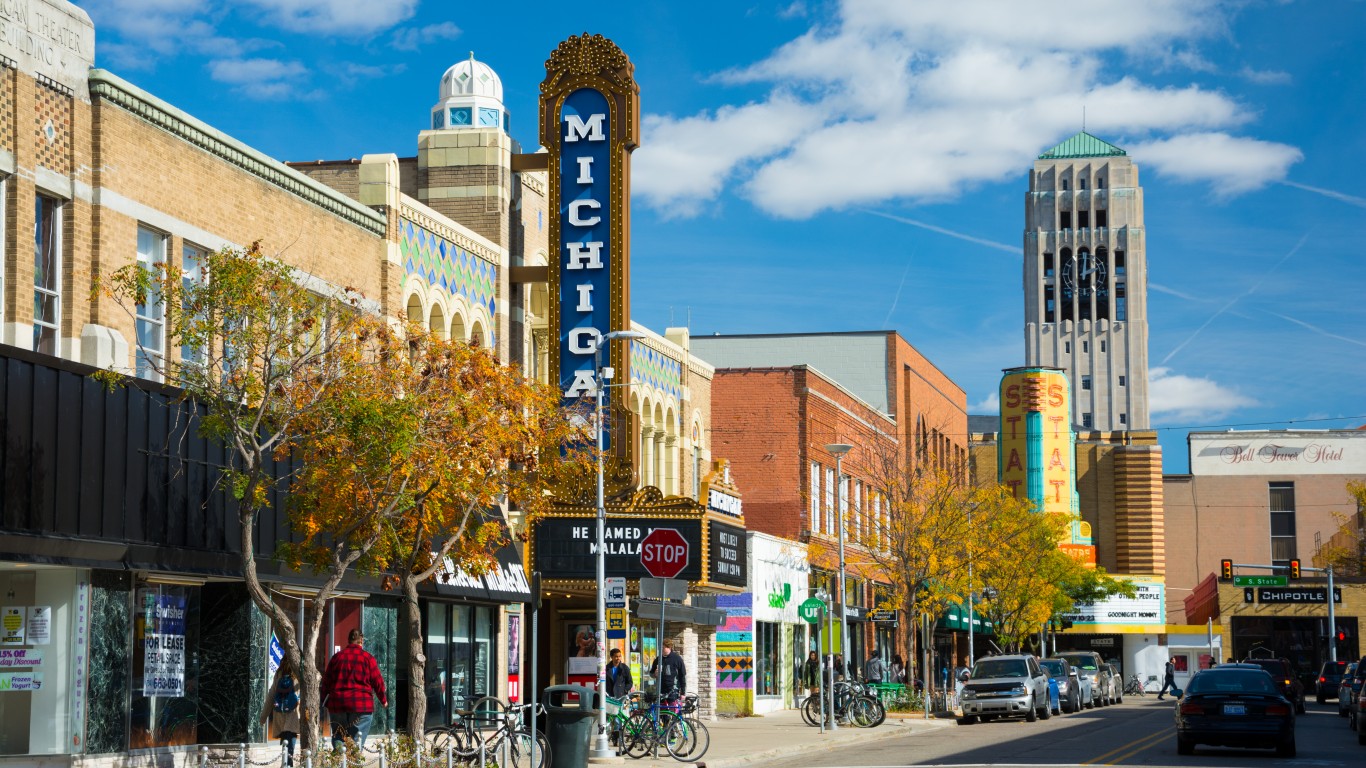Special Report
The Metro With the Lowest Child Poverty Rate in Every State

Published:

More than 40 million Americans live below the poverty line, and of those facing such financial hardship, children are disproportionately affected. Nearly 12.6 million children under age 18 live in households with poverty level income.
Not only are children at higher risk of poverty, they are also especially vulnerable to poverty’s harmful effects, both in the immediate and long-term. Childhood poverty can negatively impact brain development and has been linked with a greater likelihood of chronic illness, shorter life expectancy, and poor emotional and behavioral health. Those who spend some or all of their childhood in poverty are also less likely to succeed in school or be financially secure later in life.
Nationwide, an estimated 17.5% of children under age 18 live below the poverty line. And though the United States has one of the worst child poverty rates among wealthy, developed countries, in parts of the U.S., child poverty is far less common than average.
Using data from the U.S. Census Bureau, 24/7 Wall St. identified the metropolitan area in each state with the lowest child poverty rate.
It is important to note that in six states – Alaska, Delaware, New Hampshire, Rhode Island, Vermont, and Wyoming – there is only one metro area with available data. As a result, the lone metro area ranks as having the lowest child poverty by default only. Among the places on this list, the child poverty rate ranges from about 6% to nearly 25% and in the majority of cases, is below both the child poverty rates statewide and nationwide. Here is a look at the income a family needs to cover normal living expenses in every state.
Households with two parents are more likely to be financially secure than those headed by a single parent, and single-mother households are especially vulnerable to financial insecurity. In most metro areas on this list, the share of households with children headed by a single mother is below the comparable statewide share and the 11.7% national share.
Click here to see the metro area with the lowest child poverty rate in every state
Click here to read our detailed methodology

Alabama: Daphne-Fairhope-Foley
> Child poverty rate: 10.0% (Alabama: 22.7%)
> Median family income, households with children: $88,176 (Alabama: $64,790)
> Share of households with children receiving SNAP benefits: 12.1% (Alabama: 22.4%)
> Households headed by single mothers: 7.4% (Alabama: 13.3%)
> No. of metros considered in ranking: 12
[in-text-ad]

Alaska: Anchorage
> Child poverty rate: 11.6% (Alaska: 13.8%)
> Median family income, households with children: $93,794 (Alaska: $88,245)
> Share of households with children receiving SNAP benefits: 13.8% (Alaska: 15.9%)
> Households headed by single mothers: 10.1% (Alaska: 10.6%)
> No. of metros considered in ranking: 1
*Because Anchorage is the only eligible metro in Alaska, it is the metro with the lowest child poverty rate by default.

Arizona: Prescott Valley-Prescott
> Child poverty rate: 16.3% (Arizona: 20.0%)
> Median family income, households with children: $64,569 (Arizona: $69,758)
> Share of households with children receiving SNAP benefits: 15.3% (Arizona: 19.3%)
> Households headed by single mothers: 6.7% (Arizona: 11.9%)
> No. of metros considered in ranking: 7
Arkansas: Fayetteville-Springdale-Rogers
> Child poverty rate: 14.4% (Arkansas: 22.0%)
> Median family income, households with children: $75,304 (Arkansas: $59,204)
> Share of households with children receiving SNAP benefits: 9.5% (Arkansas: 18.7%)
> Households headed by single mothers: 10.3% (Arkansas: 13.2%)
> No. of metros considered in ranking: 6
[in-text-ad-2]

California: San Jose-Sunnyvale-Santa Clara
> Child poverty rate: 7.5% (California: 16.8%)
> Median family income, households with children: $160,683 (California: $84,790)
> Share of households with children receiving SNAP benefits: 7.1% (California: 16.1%)
> Households headed by single mothers: 7.1% (California: 10.8%)
> No. of metros considered in ranking: 26

Colorado: Boulder
> Child poverty rate: 6.4% (Colorado: 11.5%)
> Median family income, households with children: $124,209 (Colorado: $91,425)
> Share of households with children receiving SNAP benefits: 6.6% (Colorado: 11.6%)
> Households headed by single mothers: 7.8% (Colorado: 9.0%)
> No. of metros considered in ranking: 7
[in-text-ad]
Connecticut: Bridgeport-Stamford-Norwalk
> Child poverty rate: 11.6% (Connecticut: 13.0%)
> Median family income, households with children: $123,238 (Connecticut: $100,115)
> Share of households with children receiving SNAP benefits: 10.6% (Connecticut: 15.3%)
> Households headed by single mothers: 9.7% (Connecticut: 11.4%)
> No. of metros considered in ranking: 4

Delaware: Dover
> Child poverty rate: 19.8% (Delaware: 17.2%)
> Median family income, households with children: $61,775 (Delaware: $79,268)
> Share of households with children receiving SNAP benefits: 25.1% (Delaware: 19.7%)
> Households headed by single mothers: 15.7% (Delaware: 12.1%)
> No. of metros considered in ranking: 1
*Because Dover is the only eligible metro in Delaware, it is the metro with the lowest child poverty rate by default.

Florida: North Port-Sarasota-Bradenton
> Child poverty rate: 15.4% (Florida: 18.7%)
> Median family income, households with children: $71,513 (Florida: $65,053)
> Share of households with children receiving SNAP benefits: 18.5% (Florida: 22.7%)
> Households headed by single mothers: 8.0% (Florida: 11.4%)
> No. of metros considered in ranking: 22
[in-text-ad-2]

Georgia: Atlanta-Sandy Springs-Alpharetta
> Child poverty rate: 16.0% (Georgia: 20.1%)
> Median family income, households with children: $81,753 (Georgia: $70,326)
> Share of households with children receiving SNAP benefits: 16.3% (Georgia: 19.6%)
> Households headed by single mothers: 13.8% (Georgia: 14.3%)
> No. of metros considered in ranking: 14

Hawaii: Kahului-Wailuku-Lahaina
> Child poverty rate: 10.1% (Hawaii: 11.7%)
> Median family income, households with children: $85,527 (Hawaii: $91,696)
> Share of households with children receiving SNAP benefits: 14.3% (Hawaii: 17.0%)
> Households headed by single mothers: 10.8% (Hawaii: 9.7%)
> No. of metros considered in ranking: 2
[in-text-ad]

Idaho: Boise City
> Child poverty rate: 11.8% (Idaho: 14.4%)
> Median family income, households with children: $77,008 (Idaho: $69,851)
> Share of households with children receiving SNAP benefits: 12.6% (Idaho: 15.3%)
> Households headed by single mothers: 8.2% (Idaho: 8.4%)
> No. of metros considered in ranking: 6

Illinois: Bloomington
> Child poverty rate: 11.7% (Illinois: 16.2%)
> Median family income, households with children: $94,631 (Illinois: $83,907)
> Share of households with children receiving SNAP benefits: 14.1% (Illinois: 19.4%)
> Households headed by single mothers: 10.3% (Illinois: 11.7%)
> No. of metros considered in ranking: 10

Indiana: Indianapolis-Carmel-Anderson
> Child poverty rate: 16.0% (Indiana: 17.6%)
> Median family income, households with children: $80,256 (Indiana: $70,859)
> Share of households with children receiving SNAP benefits: 13.5% (Indiana: 16.0%)
> Households headed by single mothers: 12.6% (Indiana: 12.0%)
> No. of metros considered in ranking: 12
[in-text-ad-2]

Iowa: Ames
> Child poverty rate: 8.6% (Iowa: 13.3%)
> Median family income, households with children: $96,831 (Iowa: $79,139)
> Share of households with children receiving SNAP benefits: 9.3% (Iowa: 16.7%)
> Households headed by single mothers: 6.5% (Iowa: 10.3%)
> No. of metros considered in ranking: 8

Kansas: Lawrence
> Child poverty rate: 12.1% (Kansas: 13.9%)
> Median family income, households with children: $88,456 (Kansas: $74,882)
> Share of households with children receiving SNAP benefits: 10.2% (Kansas: 11.6%)
> Households headed by single mothers: 8.5% (Kansas: 10.4%)
> No. of metros considered in ranking: 4
[in-text-ad]
Kentucky: Elizabethtown-Fort Knox
> Child poverty rate: 14.7% (Kentucky: 22.2%)
> Median family income, households with children: $67,864 (Kentucky: $65,096)
> Share of households with children receiving SNAP benefits: 13.5% (Kentucky: 20.8%)
> Households headed by single mothers: 11.9% (Kentucky: 12.2%)
> No. of metros considered in ranking: 5

Louisiana: Baton Rouge
> Child poverty rate: 20.6% (Louisiana: 26.3%)
> Median family income, households with children: $78,298 (Louisiana: $61,722)
> Share of households with children receiving SNAP benefits: 22.7% (Louisiana: 24.9%)
> Households headed by single mothers: 15.6% (Louisiana: 16.0%)
> No. of metros considered in ranking: 9

Maine: Portland-South Portland
> Child poverty rate: 9.0% (Maine: 14.0%)
> Median family income, households with children: $96,171 (Maine: $76,852)
> Share of households with children receiving SNAP benefits: 13.6% (Maine: 18.4%)
> Households headed by single mothers: 8.3% (Maine: 9.1%)
> No. of metros considered in ranking: 3
[in-text-ad-2]

Maryland: Baltimore-Columbia-Towson
> Child poverty rate: 12.6% (Maryland: 11.6%)
> Median family income, households with children: $105,288 (Maryland: $103,641)
> Share of households with children receiving SNAP benefits: 16.8% (Maryland: 15.5%)
> Households headed by single mothers: 12.8% (Maryland: 12.2%)
> No. of metros considered in ranking: 4

Massachusetts: Barnstable Town
> Child poverty rate: 9.0% (Massachusetts: 12.2%)
> Median family income, households with children: $100,000 (Massachusetts: $109,908)
> Share of households with children receiving SNAP benefits: 12.9% (Massachusetts: 15.8%)
> Households headed by single mothers: 6.3% (Massachusetts: 11.1%)
> No. of metros considered in ranking: 5
[in-text-ad]

Michigan: Ann Arbor
> Child poverty rate: 11.1% (Michigan: 18.8%)
> Median family income, households with children: $108,886 (Michigan: $73,187)
> Share of households with children receiving SNAP benefits: 11.0% (Michigan: 19.7%)
> Households headed by single mothers: 8.4% (Michigan: 11.5%)
> No. of metros considered in ranking: 14

Minnesota: Rochester
> Child poverty rate: 9.4% (Minnesota: 11.6%)
> Median family income, households with children: $97,704 (Minnesota: $95,628)
> Share of households with children receiving SNAP benefits: 9.4% (Minnesota: 11.6%)
> Households headed by single mothers: 8.6% (Minnesota: 9.8%)
> No. of metros considered in ranking: 5

Mississippi: Gulfport-Biloxi
> Child poverty rate: 24.6% (Mississippi: 27.6%)
> Median family income, households with children: $56,689 (Mississippi: $54,822)
> Share of households with children receiving SNAP benefits: 24.0% (Mississippi: 24.2%)
> Households headed by single mothers: 16.3% (Mississippi: 16.8%)
> No. of metros considered in ranking: 3
[in-text-ad-2]

Missouri: Jefferson City
> Child poverty rate: 12.8% (Missouri: 17.4%)
> Median family income, households with children: $70,548 (Missouri: $72,033)
> Share of households with children receiving SNAP benefits: 13.8% (Missouri: 17.2%)
> Households headed by single mothers: 9.6% (Missouri: 11.5%)
> No. of metros considered in ranking: 8

Montana: Billings
> Child poverty rate: 11.4% (Montana: 15.2%)
> Median family income, households with children: $80,302 (Montana: $71,986)
> Share of households with children receiving SNAP benefits: 12.8% (Montana: 16.2%)
> Households headed by single mothers: 9.3% (Montana: 8.4%)
> No. of metros considered in ranking: 3
[in-text-ad]

Nebraska: Omaha-Council Bluffs
> Child poverty rate: 11.2% (Nebraska: 12.2%)
> Median family income, households with children: $88,991 (Nebraska: $77,982)
> Share of households with children receiving SNAP benefits: 13.3% (Nebraska: 13.9%)
> Households headed by single mothers: 11.1% (Nebraska: 10.4%)
> No. of metros considered in ranking: 3

Nevada: Reno
> Child poverty rate: 13.4% (Nevada: 17.6%)
> Median family income, households with children: $76,200 (Nevada: $67,738)
> Share of households with children receiving SNAP benefits: 16.3% (Nevada: 18.7%)
> Households headed by single mothers: 11.0% (Nevada: 12.8%)
> No. of metros considered in ranking: 2

New Hampshire: Manchester-Nashua
> Child poverty rate: 9.9% (New Hampshire: 8.9%)
> Median family income, households with children: $103,297 (New Hampshire: $100,798)
> Share of households with children receiving SNAP benefits: 12.1% (New Hampshire: 11.3%)
> Households headed by single mothers: 9.1% (New Hampshire: 8.2%)
> No. of metros considered in ranking: 1
*Because Manchester-Nashua is the only eligible metro in New Hampshire, it is the metro with the lowest child poverty rate by default.
[in-text-ad-2]

New Jersey: Trenton-Princeton
> Child poverty rate: 15.3% (New Jersey: 13.3%)
> Median family income, households with children: $108,877 (New Jersey: $106,937)
> Share of households with children receiving SNAP benefits: 10.7% (New Jersey: 12.6%)
> Households headed by single mothers: 11.9% (New Jersey: 10.3%)
> No. of metros considered in ranking: 3

New Mexico: Santa Fe
> Child poverty rate: 20.0% (New Mexico: 25.6%)
> Median family income, households with children: $53,539 (New Mexico: $54,886)
> Share of households with children receiving SNAP benefits: 22.5% (New Mexico: 28.4%)
> Households headed by single mothers: 11.7% (New Mexico: 14.0%)
> No. of metros considered in ranking: 4
[in-text-ad]

New York: Glens Falls
> Child poverty rate: 11.7% (New York: 18.7%)
> Median family income, households with children: $69,994 (New York: $83,272)
> Share of households with children receiving SNAP benefits: 16.4% (New York: 19.4%)
> Households headed by single mothers: 9.7% (New York: 12.4%)
> No. of metros considered in ranking: 13

North Carolina: Raleigh-Cary
> Child poverty rate: 12.2% (North Carolina: 20.0%)
> Median family income, households with children: $101,880 (North Carolina: $68,688)
> Share of households with children receiving SNAP benefits: 11.2% (North Carolina: 20.0%)
> Households headed by single mothers: 10.7% (North Carolina: 12.5%)
> No. of metros considered in ranking: 15

North Dakota: Bismarck
> Child poverty rate: 6.9% (North Dakota: 11.1%)
> Median family income, households with children: $96,078 (North Dakota: $86,414)
> Share of households with children receiving SNAP benefits: 9.1% (North Dakota: 10.9%)
> Households headed by single mothers: 9.9% (North Dakota: 9.2%)
> No. of metros considered in ranking: 3
[in-text-ad-2]

Ohio: Cincinnati
> Child poverty rate: 15.8% (Ohio: 19.1%)
> Median family income, households with children: $85,663 (Ohio: $72,130)
> Share of households with children receiving SNAP benefits: 15.0% (Ohio: 19.8%)
> Households headed by single mothers: 12.2% (Ohio: 12.8%)
> No. of metros considered in ranking: 11

Oklahoma: Enid
> Child poverty rate: 17.8% (Oklahoma: 20.7%)
> Median family income, households with children: $67,135 (Oklahoma: $62,535)
> Share of households with children receiving SNAP benefits: 21.9% (Oklahoma: 20.6%)
> Households headed by single mothers: 12.3% (Oklahoma: 12.5%)
> No. of metros considered in ranking: 4
[in-text-ad]

Oregon: Bend
> Child poverty rate: 11.9% (Oregon: 15.0%)
> Median family income, households with children: $81,718 (Oregon: $78,939)
> Share of households with children receiving SNAP benefits: 17.1% (Oregon: 21.6%)
> Households headed by single mothers: 7.3% (Oregon: 9.9%)
> No. of metros considered in ranking: 8

Pennsylvania: State College
> Child poverty rate: 9.7% (Pennsylvania: 16.7%)
> Median family income, households with children: $101,178 (Pennsylvania: $81,257)
> Share of households with children receiving SNAP benefits: 8.6% (Pennsylvania: 20.3%)
> Households headed by single mothers: 4.9% (Pennsylvania: 11.1%)
> No. of metros considered in ranking: 18

Rhode Island: Providence-Warwick
> Child poverty rate: 15.5% (Rhode Island: 15.6%)
> Median family income, households with children: $84,422 (Rhode Island: $83,161)
> Share of households with children receiving SNAP benefits: 21.5% (Rhode Island: 21.0%)
> Households headed by single mothers: 13.1% (Rhode Island: 12.5%)
> No. of metros considered in ranking: 1
*Because Providence-Warwick is the only eligible metro in Rhode Island, it is the metro with the lowest child poverty rate by default.
[in-text-ad-2]

South Carolina: Greenville-Anderson
> Child poverty rate: 17.5% (South Carolina: 21.2%)
> Median family income, households with children: $72,645 (South Carolina: $64,942)
> Share of households with children receiving SNAP benefits: 15.7% (South Carolina: 20.0%)
> Households headed by single mothers: 11.0% (South Carolina: 13.4%)
> No. of metros considered in ranking: 8

South Dakota: Sioux Falls
> Child poverty rate: 8.6% (South Dakota: 16.1%)
> Median family income, households with children: $84,784 (South Dakota: $76,789)
> Share of households with children receiving SNAP benefits: 12.5% (South Dakota: 15.8%)
> Households headed by single mothers: 11.3% (South Dakota: 10.3%)
> No. of metros considered in ranking: 2
[in-text-ad]

Tennessee: Nashville-Davidson-Murfreesboro-Franklin
> Child poverty rate: 15.0% (Tennessee: 20.8%)
> Median family income, households with children: $80,680 (Tennessee: $65,852)
> Share of households with children receiving SNAP benefits: 14.3% (Tennessee: 20.9%)
> Households headed by single mothers: 11.3% (Tennessee: 12.4%)
> No. of metros considered in ranking: 10

Texas: Austin-Round Rock-Georgetown
> Child poverty rate: 11.9% (Texas: 20.0%)
> Median family income, households with children: $100,756 (Texas: $71,693)
> Share of households with children receiving SNAP benefits: 11.6% (Texas: 19.3%)
> Households headed by single mothers: 10.4% (Texas: 13.2%)
> No. of metros considered in ranking: 25

Utah: Ogden-Clearfield
> Child poverty rate: 7.9% (Utah: 9.9%)
> Median family income, households with children: $85,016 (Utah: $84,298)
> Share of households with children receiving SNAP benefits: 8.7% (Utah: 9.4%)
> Households headed by single mothers: 8.1% (Utah: 7.7%)
> No. of metros considered in ranking: 5
[in-text-ad-2]

Vermont: Burlington-South Burlington
> Child poverty rate: 9.6% (Vermont: 12.3%)
> Median family income, households with children: $98,361 (Vermont: $81,902)
> Share of households with children receiving SNAP benefits: 10.1% (Vermont: 15.2%)
> Households headed by single mothers: 8.6% (Vermont: 9.5%)
> No. of metros considered in ranking: 1
*Because Burlington-South Burlington is the only eligible metro in Vermont, it is the metro with the lowest child poverty rate by default.

Virginia: Harrisonburg
> Child poverty rate: 11.3% (Virginia: 13.1%)
> Median family income, households with children: $70,086 (Virginia: $93,828)
> Share of households with children receiving SNAP benefits: 12.9% (Virginia: 13.1%)
> Households headed by single mothers: 10.2% (Virginia: 10.8%)
> No. of metros considered in ranking: 9
[in-text-ad]

Washington: Seattle-Tacoma-Bellevue
> Child poverty rate: 9.9% (Washington: 12.6%)
> Median family income, households with children: $110,397 (Washington: $90,447)
> Share of households with children receiving SNAP benefits: 12.3% (Washington: 16.0%)
> Households headed by single mothers: 8.7% (Washington: 9.4%)
> No. of metros considered in ranking: 11

West Virginia: Morgantown
> Child poverty rate: 16.7% (West Virginia: 23.1%)
> Median family income, households with children: $85,242 (West Virginia: $59,938)
> Share of households with children receiving SNAP benefits: 17.2% (West Virginia: 26.8%)
> Households headed by single mothers: 8.3% (West Virginia: 10.3%)
> No. of metros considered in ranking: 7
Wisconsin: La Crosse-Onalaska
> Child poverty rate: 7.0% (Wisconsin: 14.2%)
> Median family income, households with children: $82,768 (Wisconsin: $81,197)
> Share of households with children receiving SNAP benefits: 13.5% (Wisconsin: 16.6%)
> Households headed by single mothers: 9.0% (Wisconsin: 10.2%)
> No. of metros considered in ranking: 11
[in-text-ad-2]

Wyoming: Casper
> Child poverty rate: 10.9% (Wyoming: 12.3%)
> Median family income, households with children: $70,803 (Wyoming: $80,825)
> Share of households with children receiving SNAP benefits: 12.4% (Wyoming: 9.2%)
> Households headed by single mothers: 13.1% (Wyoming: 8.7%)
> No. of metros considered in ranking: 1
*Because Casper is the only eligible metro in Wyoming, it is the metro with the lowest child poverty rate by default.
Methodology
To determine the metro area with the lowest child poverty rate in every state, 24/7 Wall St. reviewed five-year estimates of child poverty rates from the U.S. Census Bureau’s 2020 American Community Survey.
We used the 384 metropolitan statistical areas as delineated by the United States Office of Management and Budget and used by the Census Bureau as our definition of metros.
Metro areas were ranked based on the share of children living in poverty. To break ties, we used the number of children living in poverty.
Additional information on median income for families with children, the share of households with children receiving benefits from the Supplemental Nutrition Assistance Program, and the share of households headed by single mothers are also five-year estimates from the 2020 ACS.
Thank you for reading! Have some feedback for us?
Contact the 24/7 Wall St. editorial team.